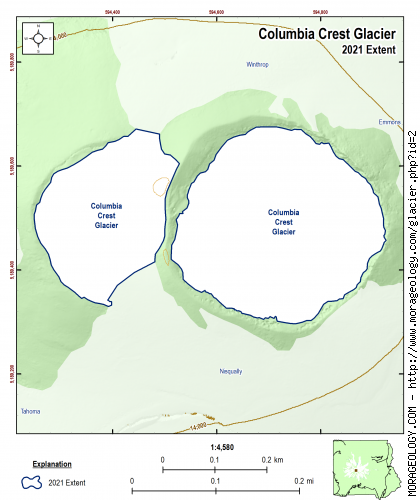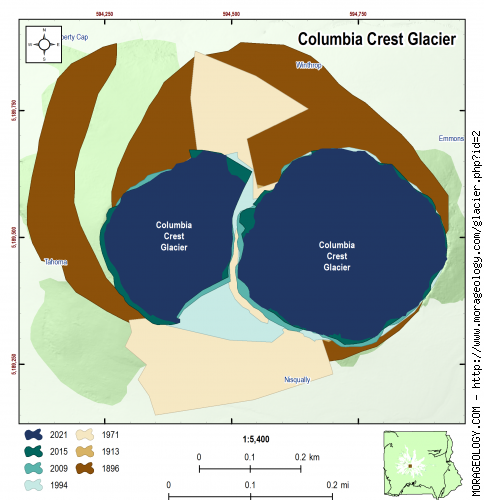NOTE: The data shown here is based on the 2021 glacier update at Mount Rainier, and should be considered the most up-to-date data on glaciers at the park (2023-04-06).
Columbia Crest Glacier
Columbia Crest is the name of the summit of Mount Rainier - The Columbia Crest Glacier occupies the summit crater. This name was suggested by H.E. Holmes of the E.S. Ingraham climbing party of 1891. The party spent two nights on the summit and before leaving jointly chose the name for it was believed at the time that it was the highest point in the United States. It was called Crater Peak by Stevens and Van Trump. A report published in the Seattle Telegraph July 28, 1894 notes that Frank W. Hawkins named it Columbia Crest while he was a member of Ingraham's July 18, 1894 conquest of the peak. (Reese, 2009)
Switch Glacier:

|
STATISTICS AS OF 2021 (Beason et al., 2023):
Aerial Extent:
0.067 ± 0.005 square miles
(0.172 ± 0.012 km2)
(Rank: 27 of 29)
Debris Cover - Based on data from 2015 (Beason, 2017):
--No appreciable debris cover in 2015--
Estimated Glacier Volume: (See notes below)
0.0006 ± 0.0002 cubic miles
(0.0024 ± 0.0008 km3)
Highest Elevation (Head):
14,393 feet
(4,387 m)
Lowest Elevation (Terminus):
14,146 feet
(4,312 m)
Elevation Range:
248 feet
(76 m)
Length:
0.43 miles
(0.68 km)
Average Slope:
9.99°
Average Flow Direction (direction the glacier flows towards):
East (96°)
Glacier Type:
S - Glacier Head Near Summit |

|
CHANGE IN EXTENT, 1896-2021 (Beason et al., 2023):
| Units |
1896 |
1913 |
1971 |
1994 |
2009 |
2015 |
2021 |
| Area, mi2 |
0.124 |
0.041 |
0.097 |
0.076 |
0.046 |
0.070 |
0.067 |
| Area, km2 |
0.322 |
0.107 |
0.251 |
0.198 |
0.118 |
0.180 |
0.172 |
Area Change Between Periods
|
1913 |
1971 |
1994 |
2009 |
2015 |
2021 |
| 1896 | -0.083 mi2
(-0.215 km2) | -0.027 mi2
(-0.071 km2) | -0.048 mi2
(-0.124 km2) | -0.079 mi2
(-0.204 km2) | -0.055 mi2
(-0.141 km2) | -0.058 mi2
(-0.149 km2) |
|---|
| 1913 | -- | 0.056 mi2
(0.144 km2) | 0.035 mi2
(0.091 km2) | 0.004 mi2
(0.011 km2) | 0.028 mi2
(0.074 km2) | 0.025 mi2
(0.065 km2) |
|---|
| 1971 | | -- | -0.020 mi2
(-0.053 km2) | -0.051 mi2
(-0.133 km2) | -0.027 mi2
(-0.070 km2) | -0.030 mi2
(-0.078 km2) |
|---|
| 1994 | | | -- | -0.031 mi2
(-0.080 km2) | -0.007 mi2
(-0.017 km2) | -0.010 mi2
(-0.025 km2) |
|---|
| 2009 | | | | -- | 0.024 mi2
(0.062 km2) | 0.021 mi2
(0.054 km2) |
|---|
| 2015 | | | | | -- | -0.003 mi2
(-0.008 km2) |
|---|
Percent Change Between Periods
|
1913 |
1971 |
1994 |
2009 |
2015 |
2021 |
| 1896 | -66.80% | -22.11% | -38.61% | -63.36% | -43.95% | -46.46% |
|---|
| 1913 | -- | 134.59% | 84.90% | 10.36% | 68.82% | 61.24% |
|---|
| 1971 | | -- | -21.18% | -52.95% | -28.04% | -31.27% |
|---|
| 1994 | | | -- | -40.31% | -8.70% | -12.80% |
|---|
| 2009 | | | | -- | 52.96% | 46.10% |
|---|
| 2015 | | | | | -- | -4.49% |
|---|
|
|
ESTIMATED CHANGE IN VOLUME, 1896-2021 (Beason et al., 2023):
PLEASE see important notes about this, below...
Glacier-specific Scaling Parameter, c:
0.026697
| Units |
1896 |
1913 |
1971 |
1994 |
2009 |
2015 |
2021 |
| Volume, mi3 |
0.0013 |
0.0003 |
0.0009 |
0.0007 |
0.0003 |
0.0006 |
0.0006 |
| Volume, km3 |
0.0055 |
0.0012 |
0.0039 |
0.0028 |
0.0014 |
0.0025 |
0.0024 |
Volume Change Between Periods
|
1913 |
1971 |
1994 |
2009 |
2015 |
2021 |
| 1896 | -0.001 mi3
(-0.004 km3) | 0.000 mi3
(-0.002 km3) | -0.001 mi3
(-0.003 km3) | -0.001 mi3
(-0.004 km3) | -0.001 mi3
(-0.003 km3) | -0.001 mi3
(-0.003 km3) |
|---|
| 1913 | -- | 0.001 mi3
(0.003 km3) | 0.000 mi3
(0.002 km3) | 0.000 mi3
(0.000 km3) | 0.000 mi3
(0.001 km3) | 0.000 mi3
(0.001 km3) |
|---|
| 1971 | | -- | 0.000 mi3
(-0.001 km3) | -0.001 mi3
(-0.003 km3) | 0.000 mi3
(-0.001 km3) | 0.000 mi3
(-0.002 km3) |
|---|
| 1994 | | | -- | 0.000 mi3
(-0.001 km3) | 0.000 mi3
(0.000 km3) | 0.000 mi3
(0.000 km3) |
|---|
| 2009 | | | | -- | 0.000 mi3
(0.001 km3) | 0.000 mi3
(0.001 km3) |
|---|
| 2015 | | | | | -- | 0.000 mi3
(0.000 km3) |
|---|
Percent Change Between Periods
|
1913 |
1971 |
1994 |
2009 |
2015 |
2021 |
| 1896 | -77.86% | -28.94% | -48.69% | -74.66% | -54.69% | -57.45% |
|---|
| 1913 | -- | 220.94% | 131.77% | 14.44% | 104.65% | 92.19% |
|---|
| 1971 | | -- | -27.78% | -64.34% | -36.23% | -40.12% |
|---|
| 1994 | | | -- | -50.63% | -11.70% | -17.08% |
|---|
| 2009 | | | | -- | 78.83% | 67.94% |
|---|
| 2015 | | | | | -- | -6.09% |
|---|
Important comments about the calculation of volume shown here
The calculation of glacial volume shown on this page is based on an analysis of two methods used at Mount Rainier in the past (Driedger and Kennard [1986]; and Nylen [2001]) as well as the most recent literature review for glacier area-volume scaling (Please review Beason et al. [2023] for an in-depth discussion about this issue). It should be noted that simply converting area to volume with an equation is extremely difficult and the values presented here have extremely large error margins (likely ± 35% or more). With that in mind, the values presented here should give you an estimate of the glacial volume and change in volume over time. Please use these data very carefully with those caveats.
The calcuation of the volume is as follows:
\[V_i = {(c_iA_i^{1.375}) + (c_nA_i^{1.36}) \over 2}\]
Where:
\(V_i\) = Average volume for the glacier in question (km3);
\(c_i\) = The glacier-specific scaling parameter (back-calculated from glacier area and volume in 1971 in Driedger and Kennard (1986); Method described in Beason et al. (2023). The value for the Columbia Crest Glacier is 0.026697 (this is also listed above the volume graph);
\(c_n\) = The back-calculated scaling parameter from Nylen (2001) of 0.0255; and
\(A_i\) = The measured volume of the glacier in question (km2).
This is essentially an average of the back-calculated Dreidger and Kennard (1986) and Nylen (2001) methods (D&K is in the first parenthesis; Nylen in the second). For example, for the Columbia Crest Glacier in 2021, you can find the following individual volumes:
Back-calculated Dreidger and Kennard (1986) Method: 0.0006 mi3 (0.0024 km3).
Back-calculated Nylen (2001) Method: 0.0006 mi3 (0.0023 km3).
Average of the two (above equation and values listed for 2021 here): 0.0006 mi3 (0.0024 km3).
Official volume estimate listed above, with error: 0.0006 ± 0.0002 mi3 (0.0024 ± 0.0008 km3).
As you can see, the D&K method tends to produce higher values and Nylen produces lower values; the average of these two methods probably estimates the glacial volume. Until further research is done in this area and we can develop a better method or equation to determine volumes, this is the method we are using to determine glacial volumes. For more information about this method, please read the methods section of Beason et al. (2023).
|
NOTES:
No outlet for this glacier, though it does exhibit downward and radial motion
RAW DATA: